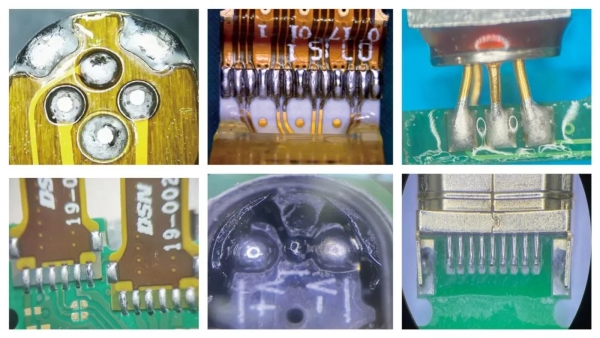What is the Appropriate Temperature for Laser Soldering?
The suitable temperature range for laser soldering is 100-400°C. Numerous online resources indicate that laser soldering systems can achieve constant temperature control at solder joints, allowing direct input of preset temperatures while equipped with real-time temperature feedback systems to ensure stability and precision during the soldering process. Furthermore, these systems maintain temperature accuracy within ±5°C with a response time of 20μs, enabling effective monitoring and adjustment of soldering temperature to guarantee both quality and efficiency. Based on years of sample testing experience by Songsheng Optoelectronics engineers, the optimal temperature range for laser soldering has been confirmed to be 100-400°C.

Laser Soldering Sample Diagram
What is the optimal temperature range for laser soldering to ensure both quality and efficiency?
The optimal temperature range for laser soldering is typically between 100°C to 400°C. During the laser soldering process, the solder joint temperature can be continuously adjusted within this 100-400°C range with precise temperature control, maintaining an accuracy of ±5°C. Additionally, the laser temperature during solder wire feeding should be higher than the preheating temperature, for example starting from 370°C.
After comprehensive consideration, to ensure both soldering quality and efficiency, the optimal temperature range for laser soldering should be set between 100°C and 400°C.
How Do Different Temperatures Affect Welding Materials During Laser Soldering?
During the laser soldering process, temperature variations significantly impact the welding materials in several ways. As temperature rises, the thermophysical properties of the soldering materials—such as thermal expansion coefficient, melting point, and solidification rate—undergo changes. These variations directly affect welding quality, including seam formation and structural stability.
Temperature increase also enhances the fluidity of flux. Within the appropriate temperature range, the flux mixes more effectively with the solder, thereby improving joint strength and reliability. However, excessively high temperatures may cause flux decomposition or evaporation, negatively impacting soldering results.
The material's laser absorption rate depends on its electrical resistivity and surface condition (e.g., smoothness), both of which are temperature-dependent. By precisely controlling laser power and soldering duration, heating speed and depth can be optimized for superior results.
The laser soldering process consists of preheating to reach the target temperature followed by sustained heating to complete the joint. Precise temperature control during these phases is critical—improper regulation may lead to defects like pores, cracks, or uneven seams.
Modern laser soldering systems typically incorporate real-time temperature feedback mechanisms. These systems continuously monitor the soldering zone's temperature and automatically adjust laser output according to programmed parameters, maintaining thermal stability throughout the process. This significantly reduces defects caused by temperature fluctuations.

Operation Process of Laser Constant Temperature Soldering System
How Does Songsheng Opto's Real-Time Temperature Feedback System Work?
The real-time temperature feedback system continuously monitors temperature variations during the soldering process and automatically adjusts laser output power according to preset parameters to maintain a constant temperature in the welding zone. This system typically employs PID (Proportional-Integral-Derivative) control algorithms to optimize temperature regulation and ensure soldering quality.
The CCD coaxial positioning system utilizes high-resolution CCD cameras to precisely locate soldering positions, ensuring accurate laser focusing on predetermined solder joints, thereby improving soldering precision and yield rates.
The constant-temperature semiconductor laser provides a stable and efficient heat source, serving as the core component for precise temperature control. Capable of rapid heating and cooling, it is particularly suitable for high-speed soldering operations.
The intelligent soft soldering software supports multiple file formats and enables integration with other systems for data exchange and processing. Additionally, it displays real-time soldering status and temperature information, assisting operators in better process control.
The temperature regulation feedback system represents an innovative solution that performs online temperature adjustments to ensure thermal stability throughout the soldering process, ultimately enhancing product quality and production efficiency.

Laser Processing Power Closed-Loop Feedback System and Constant-Temperature Semiconductor Laser Diagram
In laser soldering, effectively controlling temperature errors to improve welding precision requires a comprehensive approach. Real-time temperature monitoring and feedback utilize infrared detection to continuously measure the thermal radiation from the workpiece, with closed-loop control systems adjusting laser power and other parameters to maintain stable temperatures in the welding zone. This automatic regulation is typically achieved through PID controllers. Advanced optical systems, incorporating multi-axis servo motion systems, semiconductor lasers with their control systems, and sophisticated software, enable real-time monitoring and adjustment of temperatures during the soldering process. These integrated systems often combine temperature feedback, precise positioning, and indicator lights to ensure consistent welding quality.
A hybrid control strategy employing both open-loop and closed-loop methods proves effective—using model-based open-loop control during the preheating phase to reach target temperatures, then switching to closed-loop control during actual soldering to adapt to changing environmental conditions and minimize temperature fluctuations. Modern laser welding equipment frequently includes dedicated temperature control modules that allow operators to set specific temperature values while automatically sensing actual temperatures, preventing soldering failures caused by uncontrolled thermal variations. Implementing high-precision temperature control systems capable of maintaining ±5°C accuracy with 20μs response times significantly enhances both soldering precision and operational efficiency.
Ultimately, precise temperature management remains the critical factor in ensuring optimal laser soldering quality. The integration of these technologies—from real-time infrared monitoring and PID-controlled power adjustment to advanced optical positioning and hybrid control strategies—forms a robust framework for maintaining thermal stability throughout the soldering process. This comprehensive temperature regulation approach addresses both equipment capabilities and environmental variables, delivering consistent, high-quality results across various applications.
Contact: Mr.Xiao
Phone: +86-13385280662
E-mail: market001@whlaser.cn
Add: Room 02, Floor 5, Building 9, Gezhouba Sun City, No. 40, Gaoxin 4th Road, Donghu New Technology Development Zone, Wuhan